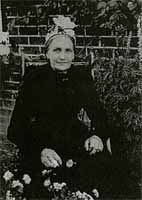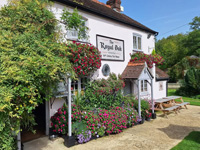History
This
West Sussex pub just off the Petersfield-Chichester road at
Hooksway is now a smart watering hole but I remember it in the
1960s when it was a run-down ale house owned by Alfie Angier.
The pub is the only remaining building of a small village which
existed on this site but was wiped out by plague - as were several
other small villages in this area, I was told, and this corner
of West Sussex remains relatively under-populated to this day.
Everybody knew about the Royal Oak but nobody quite knew how
to get there, but eventually I struck lucky and managed to visit
the place. This was the late 1960s and the pub served no wines
or spirits, only beer some of which was brewed on the premises.
There
was no counter, only a serving hatch in the single bar and no
electricity either - lighting was by oil lamps (Heaven help
you if you needed to go outside to the Gents on a dark night).
The huge wooden table and seating looked as if it had been there
since the time of the Tudors, but there was one chair nobody
dare sit down on.
This
was the seat of the landlord, Alfie Angier, who would sit there
most evenings regaling his customers with the oft told story
of the day in the early 1930s when the Prince of Wales (later
King Edward VIII) called in there on the way to or from the
racing at Goodwood. I hope somebody photographed the place for
posterity prior to its 'renovation' and the arrival of mains
water and electricty.
Life
at the Royal Oak, Hooksway, a century ago, when my maternal
grandparents were in charge, was hugely different from what
it is today.
It
was an old-style ale house, a villagers' meeting place, little
changed since it was built in the 1400s. There were oil lamps
to be lit, brick and stone-flagged floors to be swept, deal
tables to be scrubbed, water to be drawn from a well and a primitive
wash-house for laundering.
But
judging from my mother's memories it had its lighter moments,
and from her parents she learned the resourcefulness and skills
which would help her survive her own hard times.
Like
many working class families of their day, William Woods and
his wife Martha knew tragedy and misfortune and it was one such
setback which led them to the Royal Oak.
The
couple were married at Stoughton in 1866 and settled in Forestside.
By 1875 they already had five children. Then William succeeded
his father as gamekeeper on the Stansted Estate, then owned
by the Wilder family but now the seat of the Earls of Bessborough.
The
appointment meant a move to Woodberry Lane at Racton on the
road from Rowlands Castle to Westbourne. There Martha gave birth
to six more children including, in 1880, my mother Emma. She
was followed three years later by triplets - two girls and a
boy. This brought the first family misfortune for within 16
months the boy and one girl had died; they are now buried together
in Forestside churchyard.
William
and Martha's last child, Ethel Louise, was born in 1885.
Three
years later misfortune struck again when William was attacked
by poachers he surprised one night. His injuries ended his career
as a gamekeeper and led to the move to the Royal Oak in November
1889. Officially William was the licensee but it was the indomitable
Martha who, besides bringing up her large brood, ruled over
the business.
For
his part William was consigned to looking after the seven acres
of pasture and woodlands which went with the inn along with
an assortment of stables, pig pens, fowl houses, barns and outhouses.
Here he kept a range of animals, grew the produce which kept
the family self-nourished and made hurdles, chestnut fencing
and the like.
Martha
meanwhile pursued an "open-all-hours" policy, ignoring
the prevailing licensing laws with impunity by the simple expedient
of regaling the local bobby with a constant supply of free beer,
eggs, wild rabbits and other produce.
 |
Martha
Woods In retirement. She died in 1925 aged 85. No photograph
exists of
William
Woods.
|
By
the time William and Martha took over the inn their two oldest
sons had already left home, to be followed later by their two
youngest sons. This still left the five young Woods girls in
residence: Caroline, Agnes, Emma, Martha (the surviving triplet)
and Ethel. Their presence was an undoubted added attraction
to the local young bucks, among them no doubt, the four Hounsome
brothers from East Marden. One of them was my father Owen.
Even
then, however, rural life was already changing. Economic turndown
and increasing farm mechanisation meant fewer jobs in agriculture.
At the same time the extension of literacy and numeracy opened
the way to new opportunities and the coming of the railway and
the steamship offered a glimpse of new horizons.
William
Woods died in 1903 aged 61 and Martha, forced to retire, moved
to Oak Cottage, Nyewood. But by then all the Woods children
had left home as had all but one member of the two large related
Hounsome families at East Marden. They moved to the towns, went
to work on the railway or joined the fighting services. Three
Hounsome brothers even emigrated to Canada, two of them as early
as the 1870s.
As
for the girls, they were mostly packed off into domestic service
in strange towns where they met their husbands and settled down.
Thus it happened with my parents, who met again by chance one
Sunday on the seafront in Brighton, where my mother was a housemaid
and my father, an erstwhile shepherd boy, had joined a furniture
removal firm. They were married in the town in 1902 and raised
their four children there.
As
for Martha, misfortune had not yet done with her for her eldest
son, James, who had moved to Portsmouth to work on the railway,
lost a leg in a shunting accident, while another son, William,
was wounded fighting with the 21st Lancers at Khartoum and,
although he survived to become a "gentleman's valet",
died at the early age of 43.
One
Woods girl, who did remain in the locality was the youngest,
Ethel, who married Arthur "Punch" Glue, a formidable
village cricketer in his day, and settled in East Harting. Living
there with them was "Uncle Jim", his amputated limb
replaced by what looked remarkably like one of the legs from
our scullery table. A kindly, philosophical man, he worked and
slept in a large shed in the garden, mending clocks and watches.
It
was from Aunt Ethel's cottage one autumn morning in 1936 when
I was just 17, that I climbed up through the mist over the shoulder
of the downs for my first visit to the Royal Oak, bearing a
string of "Punch" Glue's home-grown onions as a gift
to the legendary, long-serving, licensee of the day, Alf Ainger.
There,
in the tap-room, little changed since my grandparents' time,
while my overcoat steamed dry before a roaring fire, I talked
about the old days with Alf over a pint of ale and a doorstep
of bread and cheese. It was a somewhat staccato conversation
since, by then, Alf was as deaf as the proverbial post.I have
returned to the Royal Oak at various times since to rediscover
my roots.
They
are nostalgic occasions. And unfailingly, as I sit in the taproom,
I fancy I hear again the echo of the Woods girls' laughter as
they flirt with the Hounsome boys, unaware that in those dying
years of the Victorian age, their world was already collapsing
and that the century ahead would bring changes beyond their
comprehension.
Postcript:
The local connection continues today through the progeny of
"Aunt Ethel" Glue. Her great-grandson is the South
Harting postman and his wife the postmistress.
Copyright
reserved
Robert Hounsome, Poole, Dorset
June, 1999
Back
to Top




